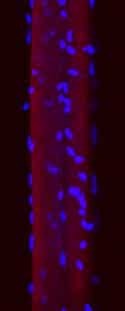Hormone replacement therapy (HRT) significantly improves muscle function – down to the muscle fibre level – in postmenopausal women, a new study published today [1 May] in The Journal of Physiology shows.
Some studies published over the last decade have led to negative publicity around HRT, a treatment used to relieve symptoms of menopause, resulting in many women being reluctant to use it. However this new study offers a positive outcome from the treatment.
Previous studies, monitoring walking speed and jumping height, have suggested that HRT reduces the impacts of age-related decline in muscle mass and strength. This new study is the first to explore these effects at cellular and molecular levels. The research team observed pairs of postmenopausal identical twins – of whom only one of each pair was receiving HRT – in order to rule out genetic differences, and then performed close examination of muscle biopsies taken from them.
Dr Lars Larsson, from Uppsala University Hospital Sweden, who led the study, said, ‘We found that even though individual muscle fibres did not change in size, the muscles of HRT users showed greater strength by generating a higher maximum force compared to non-HRT users. It is thought that using HRT, at least in part, reduces modifications of muscle contractile proteins that are linked to ageing.’
‘HRT is also associated with a more efficient organisation of myonuclei, which are essential components for muscle fibre function. In HRT users, the different myonuclei arrangement optimises cellular level protein transport that leads to improved muscle function.’ Fall and fall-related injuries are common among elderly individuals, with significant socioeconomic consequences for individuals and society, and women are affected more than men due to the decrease in female sex hormone production.’
‘Future studies are focusing on the molecular mechanisms underlying the ageing-related changes in skeletal muscle and the specific effects of HRT on the structure and function of the dominant protein in skeletal muscle, called myosin, which generates force and movement.’
These findings open up possibilities for future pharmacological interventions aimed at enhancing muscle mass and function in old age, and improving quality of life.

Image 1: Modelling of fibre and myonuclear domains (blue), as (A) an elliptical cylinder and (B) 3D representation of organisation.

Image 2: Confocal microscopy showing myonuclei (blue) in an individual muscle fibre (red).
ENDS
Notes for Editors
- Full paper: Qaisar, R, Renaud, G, Hedstrom, Y, Pöllänen, E, Ronkainen, P, Kaprio, J, … & Larsson, L (2013) Hormone replacement therapy improves contractile function and myonuclear organization of single muscle fibres from postmenopausal monozygotic female twin pairs. The Journal of Physiology,591(9), 2333-2344. doi:10.1113/jphysiol.2012.250092. This paper will have free access from 10pm PST 30 April to 31 May. Please contact Lucy Holmes (details below) if you wish to be sent the whole research paper before this time.
- The Journal of Physiology publishes advances in physiology which increase our understanding of how our bodies function in health and disease. http://jp.physoc.org
- The Physiological Society publishes the latest developments in the field in its two leading scientific journals, The Journal of Physiology and Experimental Physiology. The Society brings together over 3000 scientists from over 60 countries and promotes physiology with the public and parliament alike. It supports physiologists by organising world-class conferences and offering grants for research. www.physoc.org
Contacts
Author
Lars Larsson, MD, PhD, Professor and Academic Chair Clinical Neurophysiology, Uppsala University Hospital, Sweden
+46 (0)18 611 34 45, +46 (0)704 25 08 46
lars.larsson@neuro.uu.se (preferred method of contact)
Press Office
Lucy Holmes, Media and Communications Officer, The Physiological Society
+44 (0)20 7269 5727
pressoffice@physoc.org
In the news
